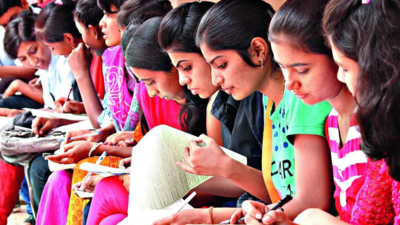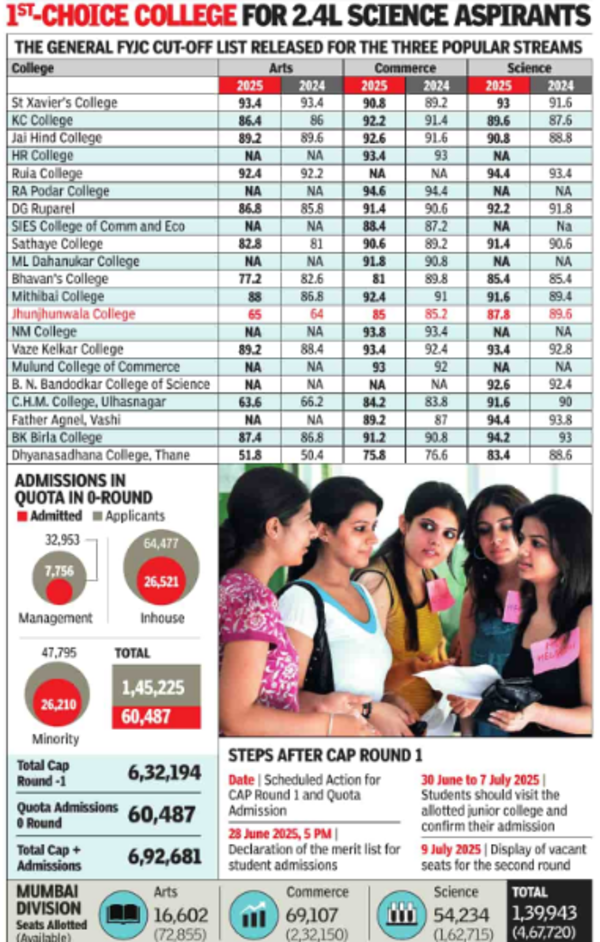ARTICLE AD BOX

Mumbai junior college admissions saw a surprising shift as the government released separate, and often higher, cutoffs for girls across streams for the first time
MUMBAI: The first cutoffs for junior college admission were released on Saturday and sprung a surprise: for the first time, the govt brought out separate cutoffs for seats reserved for girls across streams.
Their percentages at most institutes were higher than the general lists by 1-2%, or more.Overall, cut-offs in the city, however, reflected little change from last year, reports Hemali Chhapia. Arts and commerce barely moved from last year's markers, while science showed a small increase.

The school education department, after a string of postponements, advanced the allotment list - initially expected Monday, bringing clarity to an anxious cohort of students.
This year, over 2.4 lakh science aspirants across Maharashtra found themselves admitted to their first-choice colleges. Commerce, too, saw 82,594 students secure their preferred seat, while 1.4 lakh humanities students were placed where they hoped.Typically, seats for girls are set aside within every category - be it general, SC, ST, or others - but the cutoffs under this quota have rarely been visible. This reservation lives within the folds of broader quotas, often unacknowledged in the final merit tables.
But for the first time, the system has let those numbers speak.With the first cutoffs for first-year junior college out on Saturday, admissions this year may come with more than just nervous anticipation and may see a rise in rejections too, said experts. Students were asked to self-certify their documents during application, a move that left some officials concerned.“It is crucial to involve schools in verifying the uploaded documents or to set up facilitation centres,” an education officer warned.
“If fairness is to be maintained, the govt must step in.”But even as the system braces for scrutiny, another quiet revolution unfolded — on the merit lists. City college principals were taken aback by a new set of numbers rising through the ranks: girl students. This year, the cutoffs for girls were declared separately, and in many cases, they not only matched the general cut-offs, they surpassed them. Mahesh Palkar, director, secondary and higher secondary education said, “This time, we have declared the scores of all students who got in through horizontal reservation too.
”“The state has, for the first time, carved out a list for 30% quota for women,” NM College principal Parag Ajgaonkar said, referencing a govt resolution dated May 6. “And the data shows that they’re outperforming expectations. Our cutoff for girls is 95.2%, while the general stood at 93.8%.” At RA Podar, the gap was just as telling: 96% for girls versus 94.6% overall. At Mithibai College, principal Krutika Desai welcomed the development: “It’s heartening to see that girls are not just claiming their seats — they’re pushing the bar higher.” At her college, the pattern held across streams. In humanities, the cutoff for girls stood at 91.6%, edging ahead of the general list at 88%. In commerce, the gap was slimmer — 93% for girls compared to 92.4% overall. And in science, too, the trend was consistent: 93% for girls, outpacing the general cut-off of 91.6%.In the case of humanities, St Xavier’s overall cutoff stood at 93.4%, unmoved from last year, but that for girls is 95.8%. “Humanities is no longer a fallback. Many are choosing it deliberately, to build something creative and lasting,” observed Himanshu Dawda, Principal of R Jhunjhunwala College. At HR College, principal Pooja Ramchandani attributed the small rise in cut-offs to better performance of the batch of Class X students.“There’s heightened competition in both science and commerce,” said KJ Somaiya College of Commerce and Science principal Pradnya Prabhu. “With students scoring exceptionally well in the SSC exams, the pressure is real.” But she urged them to examine their strengths before chasing a seat. Across Maharashtra, 10.7 lakh students applied for a place through the Centralised Admission Process (CAP), but only 6.9 lakh were allotted a seat.



.png)
.png)
.png)
















 4 hours ago
3
4 hours ago
3









 English (US) ·
English (US) ·